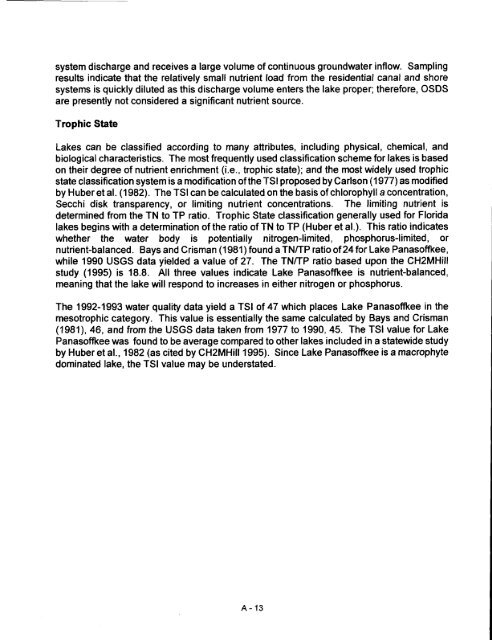Lake Panasoffkee SWIM Plan - Southwest Florida Water ...
Lake Panasoffkee SWIM Plan - Southwest Florida Water ...
Lake Panasoffkee SWIM Plan - Southwest Florida Water ...
Create successful ePaper yourself
Turn your PDF publications into a flip-book with our unique Google optimized e-Paper software.
system discharge and receives a large volume of continuous groundwater inflow. Sampling<br />
results indicate that the relatively small nutrient load from the residential canal and shore<br />
systems is quickly diluted as this discharge volume enters the lake proper; therefore, OSDS<br />
are presently not considered a significant nutrient source.<br />
Trophic State<br />
<strong>Lake</strong>s can be classified according to many attributes, including physical, chemical, and<br />
biological characteristics. The most frequently used classification scheme for lakes is based<br />
on their degree of nutrient enrichment (i.e., trophic state); and the most widely used trophic<br />
state classification system is a modification of the TSI proposed by Carlson (1 977) as modified<br />
by Huber et al. (1982). The TSI can be calculated on the basis of chlorophyll a concentration,<br />
Secchi disk transparency, or limiting nutrient concentrations. The limiting nutrient is<br />
determined from the TN to TP ratio. Trophic State classification generally used for <strong>Florida</strong><br />
lakes begins with a determination of the ratio of TN to TP (Huber et al.). This ratio indicates<br />
whether the water body is potentially nitrogen-limited, phosphorus-limited, or<br />
nutrient-balanced. Bays and Crisman (1981) found a TN/TP ratio of 24 for <strong>Lake</strong> <strong>Panasoffkee</strong>,<br />
while 1990 USGS data yielded a value of 27. The TNiTP ratio based upon the CH2MHill<br />
study (1995) is 18.8. All three values indicate <strong>Lake</strong> <strong>Panasoffkee</strong> is nutrient-balanced,<br />
meaning that the lake will respond to increases in either nitrogen or phosphorus.<br />
The 1992-1993 water quality data yield a TSI of 47 which places <strong>Lake</strong> Panasornee in the<br />
mesotrophic category. This value is essentially the same calculated by Bays and Crisman<br />
(1981), 46, and from the USGS data taken from 1977 to 1990, 45. The TSI value for <strong>Lake</strong><br />
<strong>Panasoffkee</strong> was found to be average compared to other lakes included in a statewide study<br />
by Huber et al., 1982 (as cited by CH2MHilll995). Since <strong>Lake</strong> <strong>Panasoffkee</strong> is a macrophyte<br />
dominated lake, the TSI value may be understated.
















